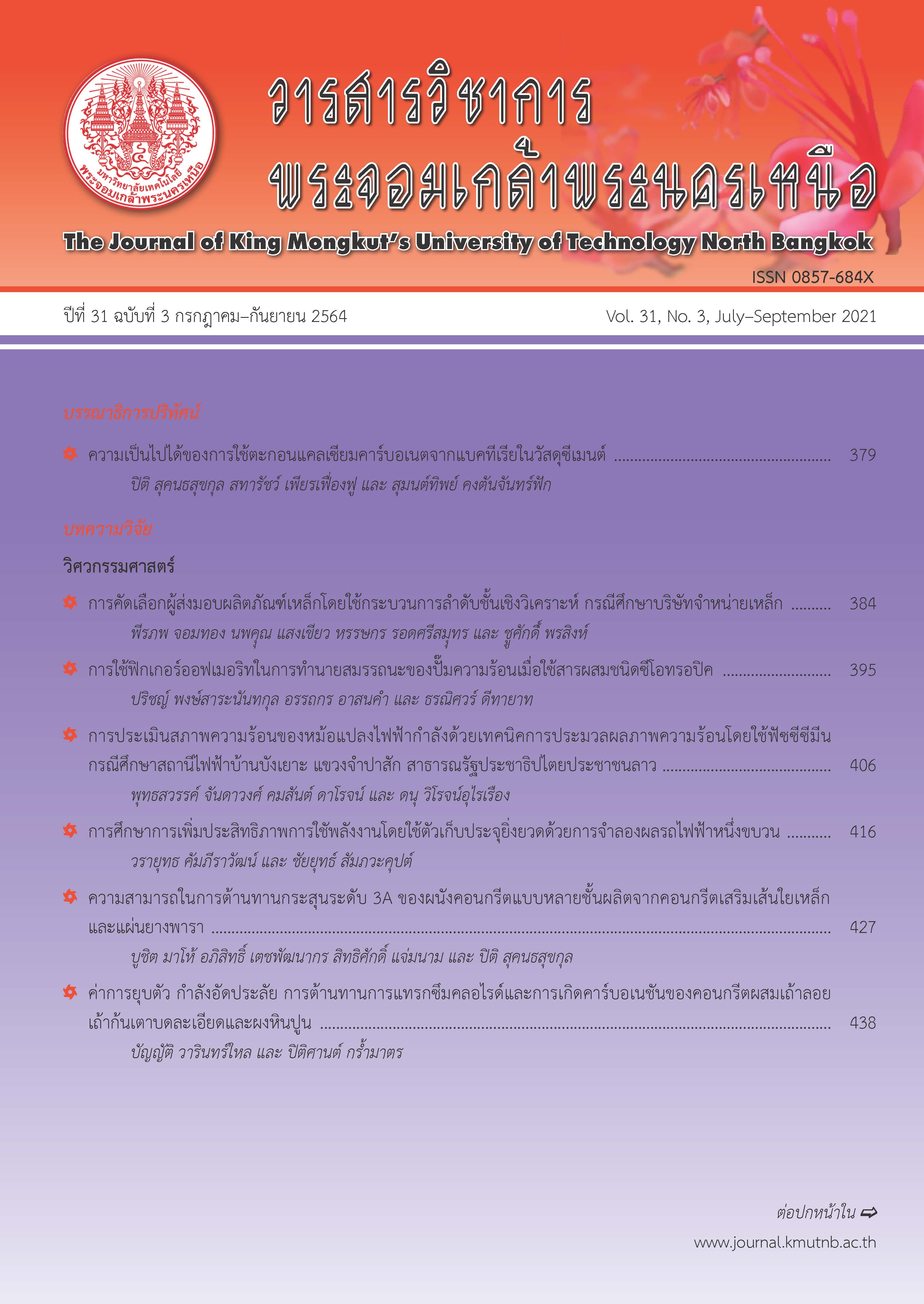ปรับปรุงเส้นโค้งกฎปฏิบัติการอ่างเก็บน้ำที่เหมาะสมด้วยการค้นหาแบบทาบู กรณีศึกษาอ่างเก็บน้ำห้วยหลวง
Main Article Content
บทคัดย่อ
การวิจัยครั้งนี้มุ่งเน้นศึกษาเพื่อหาค่าเหมาะสมที่ดีที่สุดของเส้นโค้งกฎปฏิบัติการอ่างเก็บน้ำด้วยวิธีการค้นหาแบบทาบู เพื่อปรับปรุงเส้นโค้งกฎปฏิบัติการอ่างเก็บน้ำ โดยพิจารณาข้อมูลเส้นโค้งกฎปฏิบัติการอ่างเก็บน้ำแบบรายเดือนของอ่างเก็บน้ำห้วยหลวง จังหวัดอุดรธานี เป็นกรณีศึกษาในครั้งนี้ โดยใช้ฟังก์ชั่นวัตถุประสงค์ 3 กรณี คือ ค่าเฉลี่ยของการขาดแคลนน้ำน้อยที่สุด ความถี่ของการขาดแคลนน้ำน้อยที่สุด และปริมาณการขาดแคลนสูงสุดที่น้อยที่สุด ในกระบวนการค้นหาคำตอบที่ดีที่สุด ในการศึกษาครั้งนี้ข้อมูลที่ใช้ประกอบไปด้วยปริมาณน้ำท่าเฉลี่ยรายเดือนที่ไหลเข้าอ่างเก็บน้ำตั้งแต่ ปี พ.ศ. 2527-2559 ข้อมูลความต้องการใช้น้ำ ข้อมูลอุทกวิทยา และข้อมูลทางกายภาพของอ่างเก็บน้ำ นอกจากนี้ยังได้สังเคราะห์ข้อมูลน้ำท่าแบบรายเดือน ที่ไหลเข้าอ่างเก็บน้ำจำนวน 1,000 เหตุการณ์ เพื่อประเมินประสิทธิภาพของเส้นโค้งกฎปฏิบัติการที่ได้จากแบบจำลอง ผลการศึกษาพบว่าเส้นโค้งกฏปฏิบัติการใหม่ ที่ได้นำฟังก์ชั่นวัตถุประสงค์ทั้ง 3 กรณี มาใช้นั้น มีรูปร่างคล้ายคลึงกับเส้นโค้งกฏปฏิบัติการเดิม และเมื่อนำเส้นโค้งกฏปฏิบัติการควบคุมใหม่นี้ไปทดสอบและเปรียบเทียบกับเส้นโค้งกฏปฏิบัติการเดิม โดยใช้เงื่อนไขเหมือนกัน พบว่าเส้นโค้งกฎปฏิบัติการใหม่ที่หาจากใช้ค่าเฉลี่ยของการขาดแคลนน้ำน้อยที่สุดเป็นฟังก์ชั่นวัตถุประสงค์ ในกระบวนการค้นหาสามารถบรรเทาสภาวะน้ำท่วมและน้ำขาดแคลนได้ดีกว่าเส้นโค้งกฏปฏิบัติการเดิม จากนั้นนำเส้นโค้งกฏปฏิบัติการที่ได้จากค่าเฉลี่ยของการขาดแคลนน้อยที่สุดมาทดสอบและเปรียบเทียบกับเส้นโค้งกฏปฏิบัติการเดิม โดยใช้ข้อมูลการไหลเข้าสู่อ่างเก็บน้ำที่สังเคราะห์จากอดีต 33 ปี จำนวน 1,000 เหตุการณ์ พบว่ามีประสิทธิภาพดีกว่าเส้นโค้งกฏปฏิบัติการเดิม
Article Details
บทความที่ลงตีพิมพ์เป็นข้อคิดเห็นของผู้เขียนเท่านั้น
ผู้เขียนจะต้องเป็นผู้รับผิดชอบต่อผลทางกฎหมายใดๆ ที่อาจเกิดขึ้นจากบทความนั้น
เอกสารอ้างอิง
[2] D. N. Kumar and F. Baliarsingh, “Folded dynamic programming for optimal operation of multireservoir system,” Water Resources Management, vol. 17, pp. 337–353, 2003.
[3] R. Jones, Generating High Resolution Climate Change Scenarios using PRECIS. Met Office Hadley Centre, UK: Exeter, 2004, pp. 40.
[4] R. Hormwichian, A. Kangrang, and A. Lamom, “Aconditional genetic algorithm model for searching optimal reservoir rule curves,” Journal of Applied Sciences, vol. 9, no. 19, pp. 3575– 3580, 2009.
[5] J. F. Chang, L. Chen, and C. L. Chang, “Optimizing the reservoir operating rule curves by genetic algorithms,” Hydrological Processes, vol. 19, no. 11, pp. 2277–2289, 2005.
[6] A. Kangrang and C. Chaleeraktrakoon, “Genetic algorithms connected simulation with smoothing function for searching rule curves,” American Journal of Applied Sciences, vol. 4, no. 2, pp. 73–79, 2007.
[7] R. Stedinger, “The performance of LDR models for preliminary design and reservoir operation,” Water Resources Research, vol. 20, no. 2, pp. 215–224, 1984.
[8] D. N. Kumar and F. Baliarsingh, “Folded dynamic programming for optimal operation of multireservoir system,” Water Resour Manage, vol. 17, no. 8, pp. 337–353, 2003.
[9] R. Hormwichian, A. Kangrang, A. Lamom, and C. Chaleeraktrakoon “Coupled operations model and a conditional differential evolution algorithm for improving reservoir management,” International Journal of Physical Sciences, vol. 4, no. 42, pp. 5701–5710, 2012.
[10] A. Kangrang and C. Lokham, “Optimal reservoir rule curves considering conditional ant colony optimization with simulation model,” American Journal of Applied Sciences, vol. 13, no. 1, pp. 154–160, 2013.
[11] A. Afshar, F. Massoumi, A. Afahar, and M. A. Marino, “State of the art review of ant colony optimization applications in water resource management,” Water Resources Management, vol. 29, pp. 3891–3904, 2015.
[12] X. S. Yang and S. Deb, “Cuckoo search via Lavy flights,” in Deb, S., Abraham, A., & Herrera, F. (Eds.), World Congress on Nature and Biologically Inspired Computing, December 2009, pp. 210–214.
[13] B. Ming, J. X. Chang, Q. Huang, Y. M. Wang, and S. Z. Huang, “Optimal operation of multi-reservoir system based-on cuckoo search algorithm,” Water Resources Management, vol. 29, no. 15, pp. 5671–5687, 2015.
[14] A. Kangrang, H. Prasanchum, and R. Hormwichian, “Development of future rule curves for multipurpose reservoir operation using conditional genetic and tubu search algorithms,” Advances in Civil Engineering, vol. 2018, no. 2, pp. 1–10, 2018.
[15] K. Saimuang and A. Kangrang, “Optimal water allocation criteria using the tabu search technique,” Journal of Science and Technology Mahasarakham University, vol 36, no 1, pp. 1–9, 2017.
[16] L. B. Rodriguez, P. A. Cello, and C. A. Vionnet, “Fully conservative coupling of HEC-RAS with MODFLOW to simulate stream–aquifer interactions in a drainage basin,” Journal of Hydrology, vol. 353, pp. 129–142, 2008.

